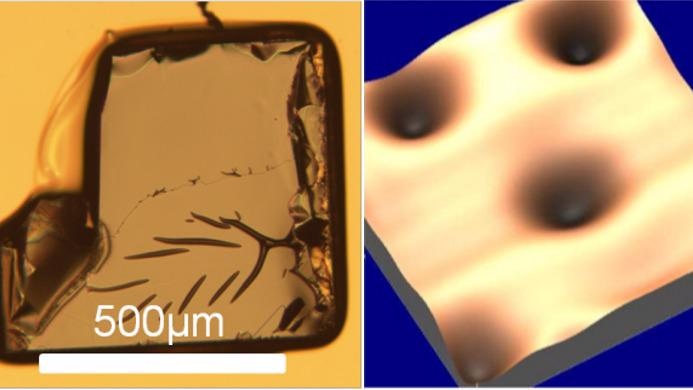Jun 2 2021
Physicists from the University of Bath, in association with scientists from the United States, have revealed a novel mechanism that allows superconductivity and magnetism to exist together in the same material.
 On the left: a crystal coated in gold—the gold coating allows the magnetic imaging tool to get within nanometers of the material’s surface. On the right: a magnetic picture of a segment of the crystal showing the vortices (dark holes) that were studied. Image Credit: University of Bath.
On the left: a crystal coated in gold—the gold coating allows the magnetic imaging tool to get within nanometers of the material’s surface. On the right: a magnetic picture of a segment of the crystal showing the vortices (dark holes) that were studied. Image Credit: University of Bath.
To date, investigators could only guess about the viability of this unique coexistence. The new findings may result in the development of superconducting devices, like advanced computer hardware, and lead to new applications in green energy technologies.
Generally, magnetism (noticed at work in fridge magnets) and superconductivity (that is, the potential of a material to pass electricity with ideal efficiency) do not make excellent companions because the alignment of the microscopic electronic magnetic particles present in ferromagnets usually damages the electron pairs that are responsible for causing superconductivity.
But in spite of this, the researchers from the University of Bath have discovered that RbEuFe4As4—the iron-based superconductor which is superconducting at less than −236 °C—shows both magnetism and superconductivity at less than −258 °C.
There’s a state in some materials where, if you get them really cold—significantly colder than the Antarctic—they become superconducting. But for this superconductivity to be taken to next-level applications, the material needs to show co-existence with magnetic properties.
David Collomb, Study Lead and Physics Postgraduate Research Student, University of Bath
“This would allow us to develop devices operating on a magnetic principle, such as magnetic memory and computation using magnetic materials, to also enjoy the benefits of superconductivity,” added Collomb.
The problem is that superconductivity is usually lost when magnetism is turned on. For many decades, scientists have tried to explore a host of materials that have both properties in a single material, and material scientists have recently had some success fabricating a handful of such materials. However, so long as we don’t understand why the coexistence is possible, the hunt for these materials can’t be done with as fine a comb.
David Collomb, Study Lead and Physics Postgraduate Research Student, University of Bath
“This new research gives us a material that has a wide temperature range where these phenomena co-exist, and this will allow us to study the interaction between magnetism and superconductivity more closely and in great detail. Hopefully, this will result in us being able to identify the mechanism through which this co-existence can occur,” added Mr Collomb.
To investigate the extraordinary behavior of RbEuFe4As4, the researchers produced magnetic field maps of a superconducting material as the temperature was decreased. The study has been published in the Physical Review Letters journal.
But to their amazement, the researchers discovered that the vortices (that is, the points in the superconducting material in which the magnetic field enters) revealed a pronounced widening close to a temperature of −258 °C. This indicated a powerful inhibition of superconductivity as the magnetism switched on.
Such observations correspond with a hypothetical model recently suggested by Dr Alexei Koshelev from the Argonne National Laboratory in the United States. This concept explains how superconductivity is suppressed by magnetic changes as a result of Europium (Eu) atoms in the crystals.
In this case, the magnetic direction of every Eu atom starts to vary and align with other atoms as the material decreases to less than a specific temperature. This makes the material magnetic. The researchers from the University of Bath thus concluded that despite being significantly weakened by the magnetic effect, superconductivity is not completely destroyed.
“This suggests that in our material, the magnetism and superconductivity are held apart from each other in their own sub-lattices, which only minimally interact,” added Mr Collomb.
This work significantly advances our understanding of these rare coexisting phenomena and could lead to possible applications in the superconducting devices of the future. It will spawn a deeper hunt into materials that display both superconductivity and magnetism. We hope it will also encourage researchers in more applied fields to take some of these materials and make the next-generation computing devices out of them.
David Collomb, Study Lead and Physics Postgraduate Research Student, University of Bath
“Hopefully, the scientific community will gradually enter an era where we move from blue-sky research to making devices from these materials. In a decade or so, we could be seeing prototype devices using this technology that do a real job,” concluded Mr Collomb.
The US collaborators for this study were the Argonne National Laboratory, Northwestern University, and Hofstra University.
Journal Reference:
Collomb, D., et al. (2021) Observing the Suppression of Superconductivity in RbEuFe4As4 by Correlated Magnetic Fluctuations. Physical Review Letters. doi.org/10.1103/PhysRevLett.126.157001.